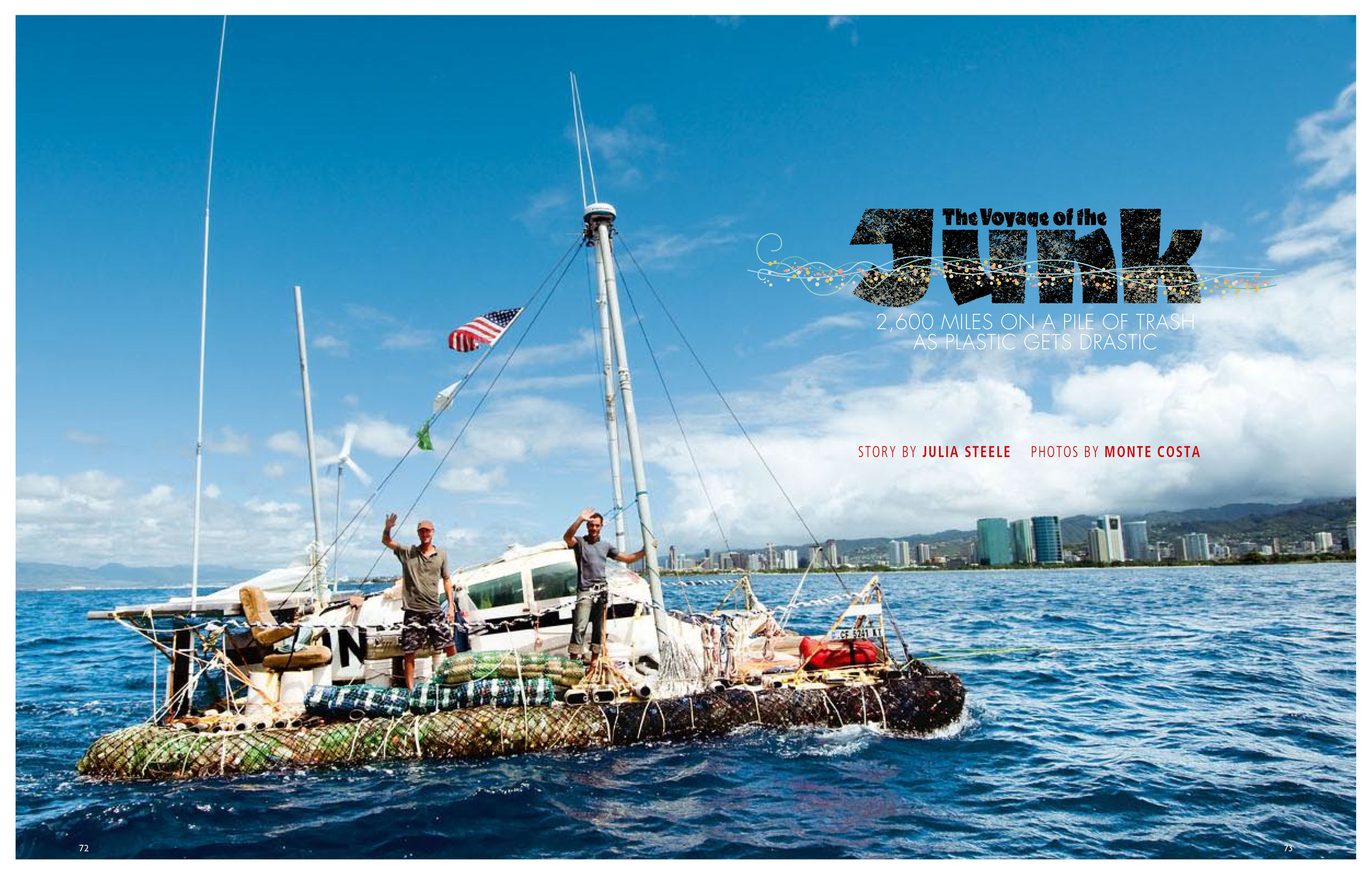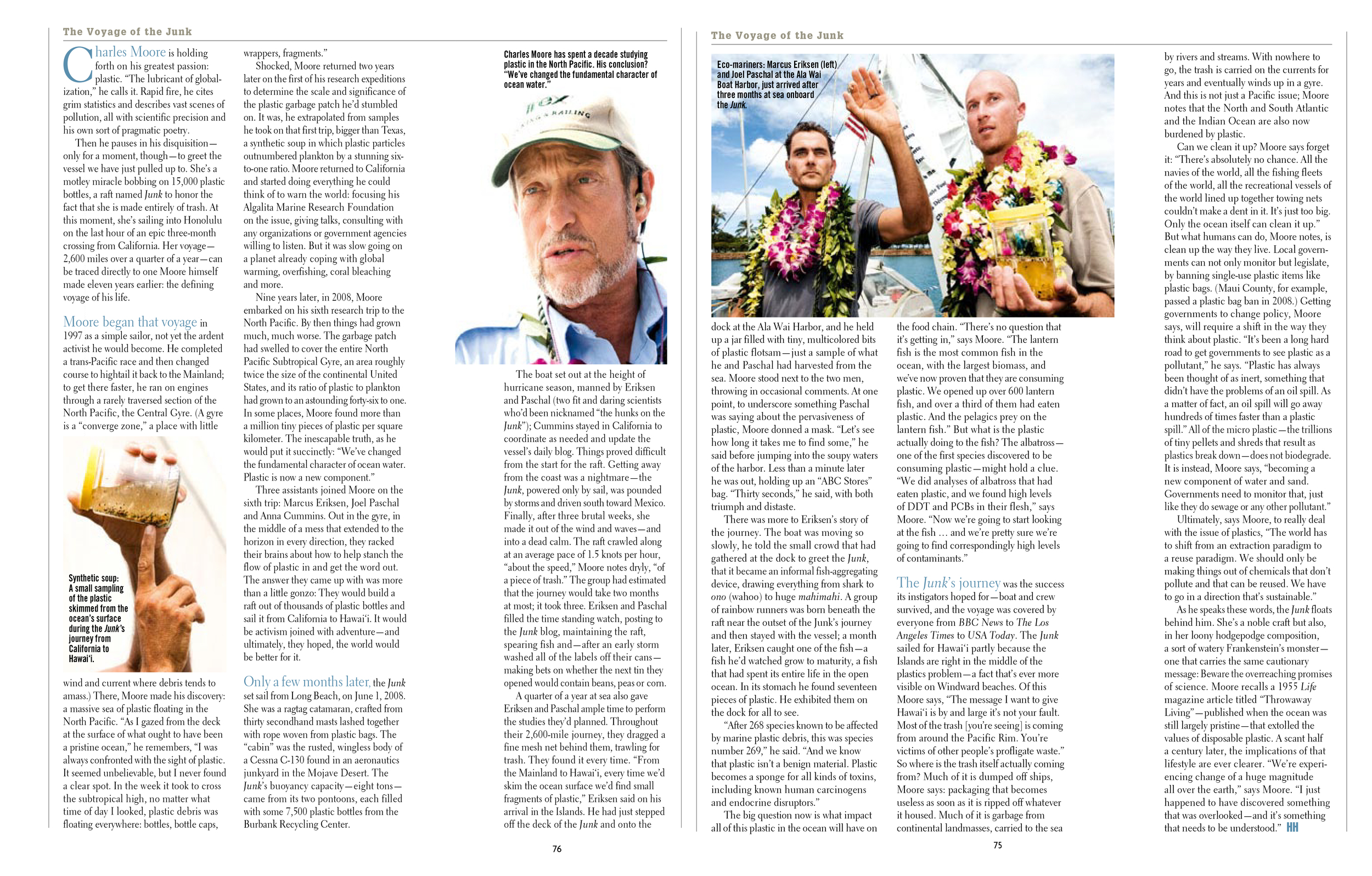Charles Moore is holding forth on his greatest passion: plastic. “The lubricant of globalization,” he calls it. Rapid fire, he cites grim statistics and describes vast scenes of pollution, all with scientific precision and his own sort of pragmatic poetry.
Then he pauses in his disquisition—only for a moment, though—to greet the vessel we have just pulled up to. She’s a motley miracle bobbing on 15,000 plastic bottles, a raft named Junk to honor the fact that she is made entirely of trash. At this moment, she’s sailing into Honolulu on the last hour of an epic three-month crossing from California. Her voyage—2,600 miles over a quarter of a year—can be traced directly to one Moore himself made eleven years earlier: the defining voyage of his life.
Moore began that voyage in 1997 as a simple sailor, not yet the ardent activist he would become. He completed a trans-Pacific race and then changed course to hightail it back to the Mainland; to get there faster, he ran on engines through a rarely traversed section of the North Pacific, the Central Gyre. (A gyre is a “converge zone,” a place with little wind and current where debris tends to amass.) There, Moore made his discovery: a massive sea of plastic floating in the North Pacific. “As I gazed from the deck at the surface of what ought to have been a pristine ocean,” he remembers, “I was always confronted with the sight of plastic. It seemed unbelievable, but I never found a clear spot. In the week it took to cross the subtropical high, no matter what time of day I looked, plastic debris was floating everywhere: bottles, bottle caps, wrappers, fragments.”
Shocked, Moore returned two years later on the first of his research expeditions to determine the scale and significance of the plastic garbage patch he’d stumbled on. It was, he extrapolated from samples he took on that first trip, bigger than Texas; a synthetic soup in which plastic particles outnumbered plankton by a stunning six-to-one ratio. Moore returned to California and started doing everything he could think of to warn the world: focusing his Algalita Marine Research Foundation on the issue, giving talks, consulting with any organizations or government agencies willing to listen. But it was slow going on a planet already coping with global warming, overfishing, coral bleaching and more.
Nine years later, in 2008, Moore embarked on his sixth research trip to the North Pacific. By then things had grown much, much worse. The garbage patch had swelled to cover the entire North Pacific Subtropical Gyre, an area roughly twice the size of the continental United States, and its ratio of plastic to plankton had grown to an astounding forty-six to one. In some places, Moore found more than a million tiny pieces of plastic per square kilometer. The inescapable truth, as he would put it succinctly: “We’ve changed the fundamental character of ocean water. Plastic is now a new component.”
Three assistants joined Moore on the sixth trip: Marcus Erikson, Joel Paschal and Anna Cummins. Out in the gyre, in the middle of a mess that extended to the horizon in every direction, they racked their brains about how to help stanch the flow of plastic in and get the word out. The answer they came up with was more than a little gonzo: They would build a raft out of thousands of plastic bottles and sail it from California to Hawai‘i. It would be activism joined with adventure—and ultimately, they hoped, the world would be better for it.
Only a few months later, the Junk set sail from Long Beach, on June 1, 2008. She was a ragtag catamaran, crafted from thirty secondhand masts lashed together with rope woven from plastic bags. The “cabin” was the rusted, wingless body of a Cessna C-130 found in an aeronautics junkyard in the Mojave Desert. The Junk’s buoyancy capacity—eight tons—came from its two pontoons, each filled with some 7,500 plastic bottles from the Burbank Recycling Center.
The boat set out at the height of hurricane season, manned by Erikson and Paschal (two fit and daring scientists who’d been nicknamed “the hunks on the Junk”); Cummins stayed in California to coordinate as needed and update the vessel’s daily blog. Things proved difficult from the start for the raft. Getting away from the coast was a nightmare—the Junk, powered only by sail, was pounded by storms and driven south toward Mexico. Finally, after three brutal weeks, she made it out of the wind and waves—and into a dead calm. The raft crawled along at an average pace of 1.5 knots per hour, “about the speed,” Moore notes dryly, “of a piece of trash.” The group had estimated that the journey would take two months at most; it took three. Erikson and Paschal filled the time standing watch, posting to the Junk blog, maintaining the raft, spearing fish and—after an early storm washed all of the labels off their cans—making bets on whether the next tin they opened would contain beans, peas or corn.
A quarter of a year at sea also gave Erikson and Paschal ample time to perform the studies they’d planned. Throughout their 2,600-mile journey, they dragged a fine mesh net behind them, trawling for trash. They found it every time. “From the Mainland to Hawai‘i, every time we’d skim the ocean surface we’d find small fragments of plastic,” Erikson said on his arrival in the Islands. He had just stepped off the deck of the Junk and onto the dock at the Ala Wai Harbor, and he held up a jar filled with tiny, multicolored bits of plastic flotsam—just a sample of what he and Paschal had harvested from the sea. Moore stood next to the two men, throwing in occasional comments. At one point, to underscore something Paschal was saying about the pervasiveness of plastic, Moore donned a mask. “Let’s see how long it takes me to find some,” he said before jumping into the soupy waters of the harbor. Less than a minute later he was out, holding up an “ABC Stores” bag. “Thirty seconds,” he said, with both triumph and distaste.
There was more to Erikson’s story of the journey. The boat was moving so slowly, he told the small crowd that had gathered at the dock to greet the Junk, that it became an informal fish-aggregating device, drawing everything from shark to ono (wahoo) to huge mahimahi. A group of rainbow runners was born beneath the raft near the outset of the Junk’s journey and then stayed with the vessel; a month later, Erikson caught one of the fish—a fish he’d watched grow to maturity, a fish that had spent its entire life in the open ocean. In its stomach he found seventeen pieces of plastic. He exhibited them on the dock for all to see.
“After 267 species known to be affected by plastic debris, this was species number 268,” he said. “And we know that plastic isn’t a benign material. Plastic becomes a sponge for all kinds of toxins, including known carcinogens and endocrine disruptors.”
The big question now is what impact all of this plastic in the ocean will have on the food chain. “There’s no question that it’s getting in,” says Moore. “The lantern fish is the most common fish in the ocean, with the largest biomass, and we’ve now proven that they are consuming plastic. We opened up over 600 lantern fish, and over a third of them had eaten plastic. And the pelagics prey on the lantern fish.” But what is the plastic actually doing to the fish? The albatross—one of the first species discovered to be consuming plastic—might hold a clue. “We did analyses of albatross that had eaten plastic, and we found high levels of DDT and PCBs in their flesh,” says Moore. “Now we’re going to start looking at the fish … and we’re pretty sure we’re going to find correspondingly high levels of contaminants.”
The Junk’s journey was the success its instigators hoped for—boat and crew survived, and the voyage was covered by everyone from BBC News to The Los Angeles Times to USA Today. The Junk sailed for Hawai‘i partly because the Islands are right in the middle of the plastics problem—a fact that’s ever more visible on Windward beaches. Of this Moore says, “The message I want to give Hawai‘i is by and large it’s not your fault. Most of the trash [you’re seeing] is coming from around the Pacific Rim. You’re victims of other people’s profligate waste.” So where is the trash itself actually coming from? Much of it is dumped off ships, Moore says: packaging that becomes useless as soon as it is ripped off whatever it housed. Much of it is garbage from continental landmasses, carried to the sea by rivers and streams. With nowhere to go, the trash is carried on the currents for years and eventually winds up in a gyre. And this is not just a Pacific issue; Moore notes that the North and South Atlantic and the Indian Ocean are also now burdened by plastic.
Can we clean it up? Moore says forget it: “There’s absolutely no chance. All the navies of the world, all the fishing fleets of the world, all the recreational vessels of the world lined up together towing nets couldn’t make a dent in it. It’s just too big. Only the ocean itself can clean it up.” But what humans can do, Moore notes, is clean up the way they live. Local governments can not only monitor but legislate, by banning single-use plastic items like plastic bags. (Maui County, for example, passed a plastic bag ban in 2008.) Getting governments to change policy, Moore says, will require a shift in the way they think about plastic. “It’s been a long hard road to get governments to see plastic as a pollutant,” he says. “Plastic has always been thought of as inert, something that didn’t have the problems of an oil spill. As a matter of fact, an oil spill will go away hundreds of times faster than a plastic spill.” All of the micro plastic—the trillions of tiny pellets and shreds that result as plastics break down—do not biodegrade. They are instead, Moore says, “becoming a new component of water and sand. Governments need to monitor that, just like they do sewage or any other pollutant.”
Ultimately, says Moore, to really deal with the issue of plastics, “The world has to shift from an extraction paradigm to a reuse paradigm. We should only be making things out of chemicals that don’t pollute and that can be reused. We have to go in a direction that’s sustainable.”
As he speaks these words, the Junk floats behind him. She’s a noble craft but also, in her loony hodgepodge composition, a sort of watery Frankenstein’s monster—one that carries the same cautionary message: Beware the overarching promises of science. Moore recalls a 1955 Life magazine article titled “Throwaway Living”—published when the ocean was still largely pristine—that extolled the values of disposable plastic. A scant half a century later, the disastrous implications of that lifestyle are ever clearer. “We’re experiencing change of a huge magnitude all over the earth,” says Moore. “I just happened to have discovered something that was overlooked—and it’s something that needs to be understood.”

